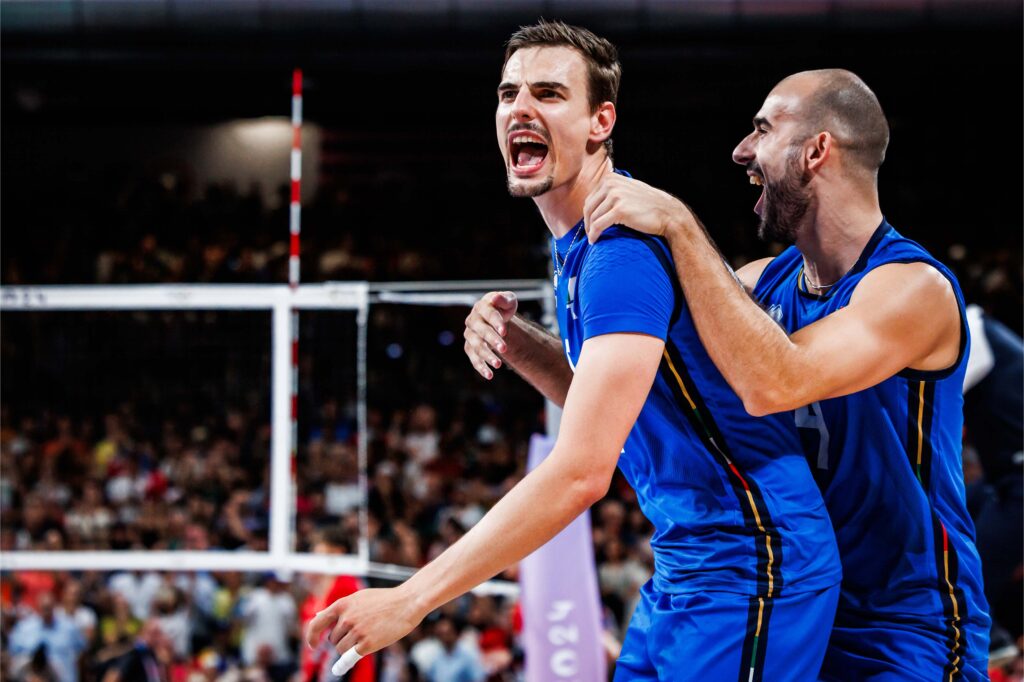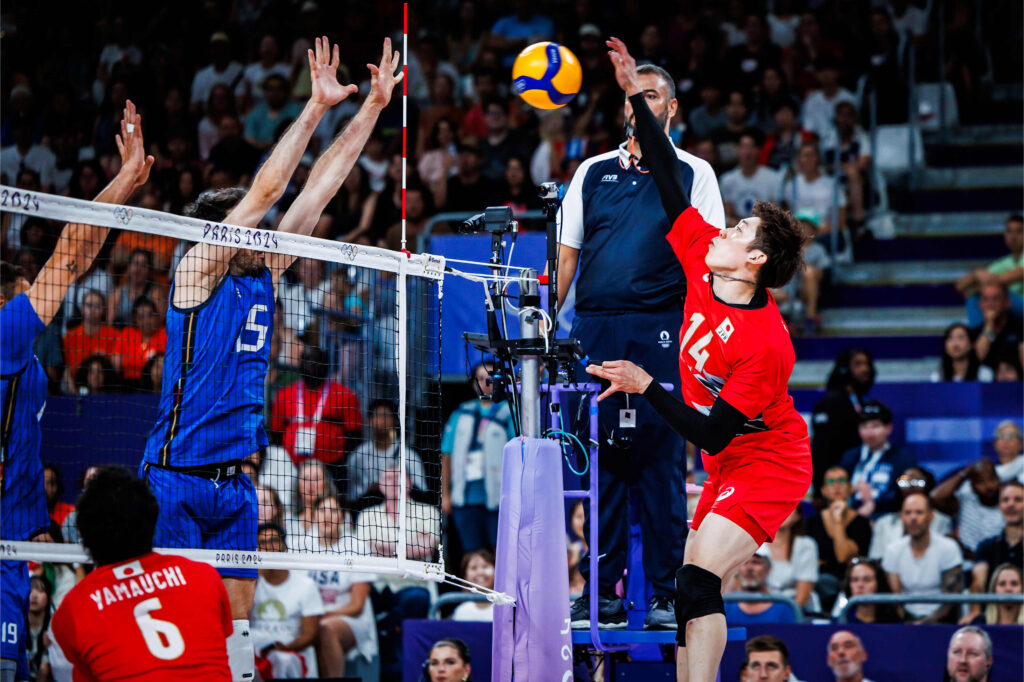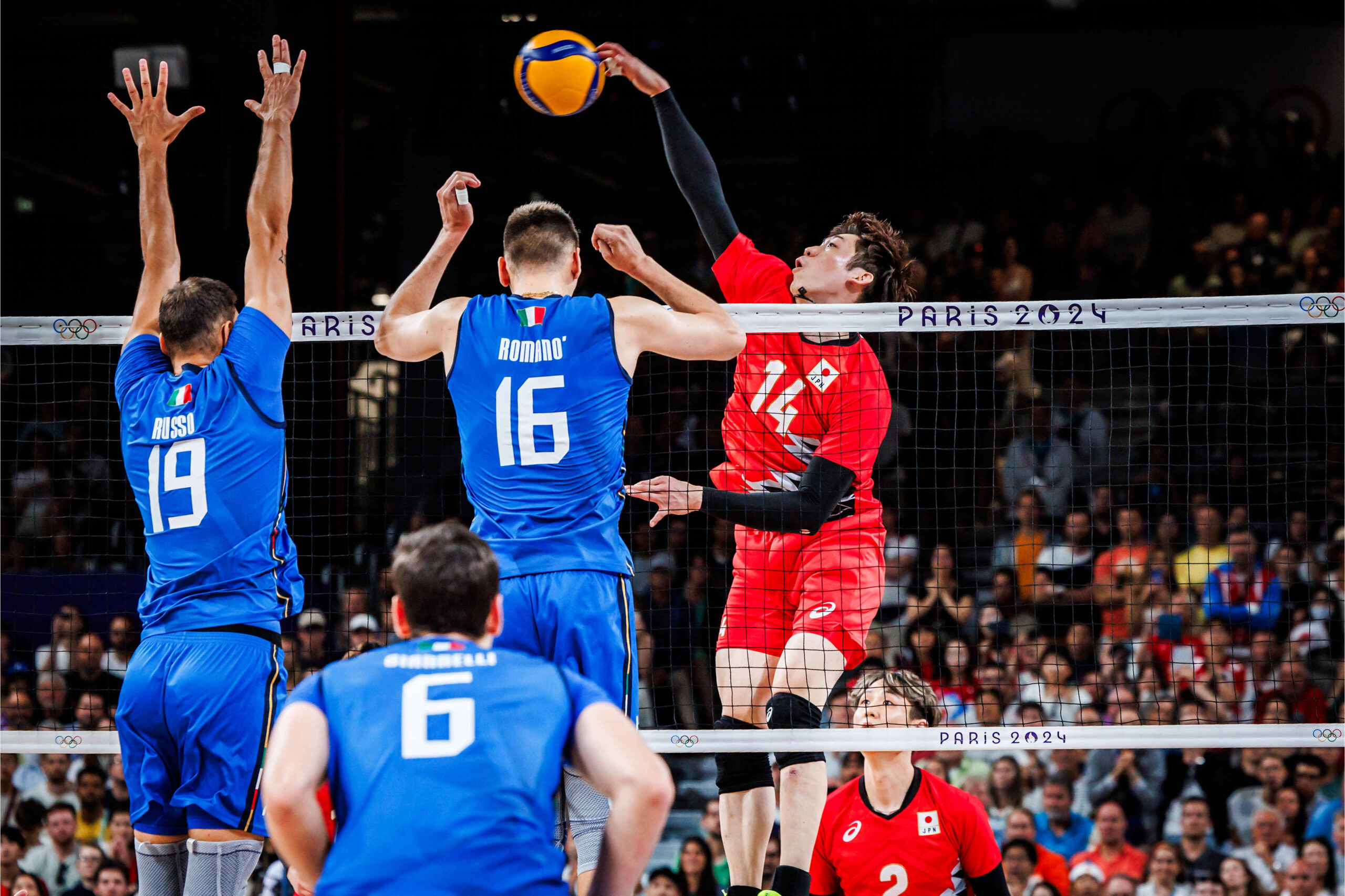The Japanese men's volleyball team played against Italy in the quarterfinals on Monday, August 5th (local time) and lost 2-3 (25-20, 25-23, 25-27, 24-26, 15-17).
Starting members
Positions: OH = Outside Hitter, MB = Middle Blocker, OP = Opposite, S = Setter, L = Libero
() is the score
Japan
OH: Ai Takahashi (16), Ishikawa (32)
MB: Yamauchi (6), Kentaro Takahashi (5)
OP: Nishida (22)
S: Sekita
L: Yamamoto
Substitutes: MB Onodera (1), S Fukatsu, OP Miyaura, OH Otsuka, OH Kai
Italy
OH: Micheletto (24), Ravia (19)
MB: Galassi (11), Russo (10)
OP: Romano (19)
S: Giannelli (5)
L: Balazo
Substitute: S. Sbertori
Match Report
Set 1
The early stages were close, but Japan took the lead 9-7 with a break chance from OH Ishikawa's serve, which led to consecutive pipe attacks. After that, OP Nishida's service ace made it 13-10, and then MB Takahashi Kentaro's serve was received, leading to five consecutive breaks from OP Nishida and OH Ishikawa's spikes, putting Japan ahead of Italy at 20-12. From there, Italy also scored consecutive points with OP Romano's service ace and MB Micheletto's block, but in the end, OH Lavia's serve was an error, and Japan took the set 25-20.
Set 2
Japan took the lead 8-6 with a service ace from OH Ishikawa, but Italy turned the game around with a service ace from OH Lavia and a block from MB Russo to take the lead 10-12. Italy further extended their lead to 13-17 with a spike from OH Lavia and a block from MB Galassi. However, Italy's mistakes and a service ace from OH Ishikawa allowed Japan to catch up at 17-17. After that, Italy took the lead again with a spike from OP Romano to take the lead at 17-19, but in the final stages, Italy took the lead again with a good defense from L Yamamoto, and OP Nishida and OH Ishikawa scored consecutive spikes to turn the game around to 24-23 and hold the set point. Finally, OH Ishikawa scored a spike to win the set 25-23.
Third set
From the beginning, Japan took the lead 6-3 with blocks from OH Takahashi Ai and a service ace from OP Nishida. From there, Japan and Italy fought for side outs with quick shots from the middle and spikes from OH Micheletto, and the match progressed to 13-9. From there, Italy narrowed the gap to 13-12 with blocks from S Gianelli, and then tied the score at 20-20 with spikes from OH Micheletto, but OH Ishikawa continued to score spikes and Japan had a match point at 24-21. However, with a spike error from OH Ishikawa, a service ace from S Gianelli, and a block from OH Micheletto to stop OP Nishida, Italy turned the game around at the last minute to 24-25 and had a set point. Japan also cut a side out with a spike from OH Ishikawa, but OH Lavia continued to score spikes and Italy took the set at 25-27.
Fourth set
Italy took the lead 3-6 with spikes from OP Romano and a service ace from MB Galassi. Japan scored mainly with spikes from OH Takahashi Ai, but Italy widened the gap to 7-11 with blocks from MB Galassi. From there, Japan closed the gap to 12-13 with service aces from OP Nishida and OH Takahashi Ai, and caught up with Italy at 19-19 with consecutive mistakes in the final stages. Japan then took the lead at 21-20 with a service ace from OH Takahashi Ai, but OH Ishikawa was caught by a block from MB Russo, allowing Japan to take the lead again at 21-22. The game then went to deuce, but MB Russo blocked consecutive spikes from OH Ishikawa and OH Takahashi Ai to give Italy the set at 24-26.
Set 5
Japan replaced MB Takahashi Kentaro with MB Onodera. In the early stages, OP Nishida's spikes put Japan ahead at 6-4, but OH Takahashi Ai's spikes made a mistake, and Italy tied the score at 8-8. Italy then broke with a pipe attack from OH Micheletto and successfully turned the game around to 10-11. From there, Japan cut a side out with OP Nishida's spike, and the game progressed to 13-13. After that, OH Takahashi Ai's serve made an error, and Italy had their first match point at 13-14, but OH Ishikawa made a spike to make it 14-14 and it was deuce. Then, OH Ishikawa made a spike from a cutback to make it 15-14 and Japan had a match point. However, a serve error by MB Onodera made the score 15-15, and then OH Ishikawa was caught in a block by OP Romano at 15-16, giving Italy another match point. OH Micheletto's serve was disrupted, preventing him from attacking in good position, and the ball he picked up with a block follow-up went back into the opponent's court, and MB Russo's direct spike made the score 15-17, giving Italy the set.
As a result, Japan lost to Italy 2-3 and was eliminated from the quarterfinals.
TOSHIKI'S MVP
Italy: Simone Giannelli
Setter 200cm Affiliation: Perugia (Italy)

5 points (1 serve, 2 blocks), team attack effectiveness rate 40.431 TP3T
Although he left the court once in the middle of the first set, the captain managed to recover and lead his team to a major comeback. In particular, in the third set, from 22-24, he continued to serve with all his might and took three consecutive breaks, including a service ace. His play was truly impressive. Although he is only 28 years old, this is his third Olympics and he already has the mentality of a veteran. Hats off to him.
Japan: Yuki Ishikawa
Outside hitter 191cm Affiliation: Perugia (Italy)

32 points (2 on serve), attack efficiency rate 34.431 TP 3T
The captain is back. He struggled in the three pool qualifying matches, unable to play to his full potential, but he made a spectacular comeback in the quarterfinals, scoring 32 points, the most for both teams. I'm sure he was very frustrated that he couldn't score on match point, but without his performance, I don't think we would have been able to fight this far against Italy, who are in top form in this tournament. He really showed great courage.
Commentary
This was a truly fierce match, with the score at just one point, and honestly it is difficult to explain what led to victory and what led to defeat, but with that as a basic premise, I would like to analyse this match by dividing it into two sections, Japan and Italy, and looking at the particularly good points of the match.
Good points about Japan
① The revival of Yuki Ishikawa
This overlaps with what I said in the MVP introduction, but it was very big that Ishikawa was able to regain his original performance. His spikes, which scored 32 points, the fourth-highest in Olympic history, were good regardless of whether he was in the front or back court, and he also served well, getting two aces and breaking the ball, and his defense was stable and he didn't collapse in serve reception. Also, Ishikawa's lively performance dispelled the slightly unpleasant atmosphere that had existed during the qualifiers, and I think the whole team was able to gain momentum in a good atmosphere.
② Total defense of blocks and receives
First of all, although there were only two block points in this match, there were many instances where Japan would block Italy's spikes and then cut back from there.
Recent opponents, not just Italy, are aware of the outstanding spike reception of L Yamamoto and OH Takahashi Ai, so they have increasingly been scoring by hitting the block rather than trying to beat the block and challenge the receiver.
Even in that situation, I think there were many scenes in this game where Japanese blockers were able to make beautiful touches and score points, rather than being used by the opponents. They also managed to hold off the opponents' mid-range attacks, which are a weakness for Japan.
In particular, OP Nishida had 9 block touches and MB Yamauchi had 7. S Sekita also had many spikes from the block, but he stretched his arms out and got 5 touches.
In terms of receiving, L Yamamoto and OH Takahashi Ai were the ones who picked up the ball with both hands or one hand, and they also chased after passes and block follow-ups, catching the ball at the last moment and saving Japan from trouble many times.
3) Aggressive serves to crush the middle
I believe that the fact that Japan's serves were performing well was definitely a major factor in Japan being able to fight this far.
It was great to see a total of seven service aces, three from OP Nishida, two each from OH Takahashi Ai and OH Ishikawa, but all the other players also served very well.
I think it was a big help that we were able to reduce the points scored by the Italian middle blockers, not only with our strong serves but also with our controlled serves, which prevented the opposing attackers from scoring.
In the qualifying matches against Germany and the United States, Japan was largely defeated by their opponents' quick serve, and Italy knew that too, and ideally would have liked to use their quick serve in better situations, but Japan's serve didn't allow that. On the other hand, they could only use their quick serve occasionally when they received a good serve, so in those situations Japan's middle serve was able to read the situation and respond well.
What was good about Italy
① Block
First and foremost, the blocks. If there is a simple answer to the question of why Japan lost to Italy, it would be the blocks.
While Japan only had two block points, Italy scored a total of 15. Among them, MB Russo was outstanding with 5 points and 10 touches, especially in the final stages when he took block points from Japan and saved Italy from difficult situations many times.
Furthermore, the Italian players did not simply try to stop the Japanese attacks, but often used tactics such as pulling back their hands after jumping to block, and countered Japan's strengths of rebounding and block-outs. Especially in the crucial moments of the second half of the match, the Italian blockers were able to win the probe and successfully lure the Japanese out or into a block.
② Fewer goals conceded in attacks
Italy conceded very few goals in attack.
Japan's receives were often picked up by them, so the effectiveness of their attacks was not that high, but they were able to keep the number of points lost through attacks to a minimum, with only 10 points in total from 2 blocks and 8 missed attacks in the full set match.
This is a very low number compared to the match against Germany, which Japan lost in the same full set, when Germany conceded 15 attacking points.
Even as the Japanese balls were being picked up by the Italian attackers, they did not slam the ball down, but instead continued to hit the ball in long courses to the back, reducing the number of points lost due to blocks and also keeping errors such as outs and in the net to a minimum.
In particular, OH Micheletto had the most spikes on the team with 48 and only conceded two points. These numbers are amazing.
3. Veteran setter Giannelli
As I wrote in the MVP introduction, the fact that Japan went from needing just one side-out to being down 24-22 to losing the set after being turned around and losing the match must have had an impact on the players' mental health until the very end of the match.
It was undoubtedly S. Giannelli who created that comeback with the serve, especially the service ace that scored the 24th point that tied the score. I don't think there are many players in the world who could serve perfectly between OH Ishikawa and L. Yamamoto, who are Japan's biggest weaknesses in that situation.
In the 2022 World Championship final, their opponent Poland had been in the lead until his serve suddenly turned the tide and they went on to win the match.
He is a player who can do that.
This is his third Olympic Games, and he won a silver medal at the Rio Olympics as a starting setter, and he won and was MVP at both the 2021 European Championships and the 2022 World Championships. If you add in his achievements with club teams, he has won the Italian league and been MVP, so his list of achievements is really endless.
It must have been fate that the serve came to him at that time, in that situation, and it was simply amazing.
Summary
Of course, I believe that this match was the result of a complex combination of many other factors and elements, but these are the points that I personally considered to be important.
In my view, it was a game in which Italy came out just a little ahead as a result of the clash of all these factors.
It's really unfortunate that Japan lost here, but I think it was a great match in which both teams gave it their all.
At the same time, it was a match that taught us the importance of one point and the fun and toughness of volleyball.
I will write about my personal impressions after the tournament is over.
Thank you to everyone on the Japanese team for your hard work. Thank you for the excitement and emotion.
[PR] "ALL for DREAM -Footsteps to Glory- Japan Volleyball National Team Nations League 2024" will be available on U-NEXT from July 27th (Sat.)
A documentary program that closely follows the unknown behind-the-scenes of the "Volleyball Nations League 2024" and traces the fierce battles will be streamed on U-NEXT.
[Distribution date and time]
July 27th (Saturday) 5pm Boys #1 Boys #2
August 3rd (Saturday) 5pm Women's #1
Saturday, August 10th 5pm Women's #2
Saturday, August 24th 5pm Men's #3
Saturday, August 31st 5pm Women's #3
September 7th (Saturday) 5pm Men's #4
Saturday, September 14th 5pm Women's #4
(Quoted from TBS TV release)
U-NEXT offers a 30-day free trial! Click the banner below to sign up!

Photo: Volleyball World
